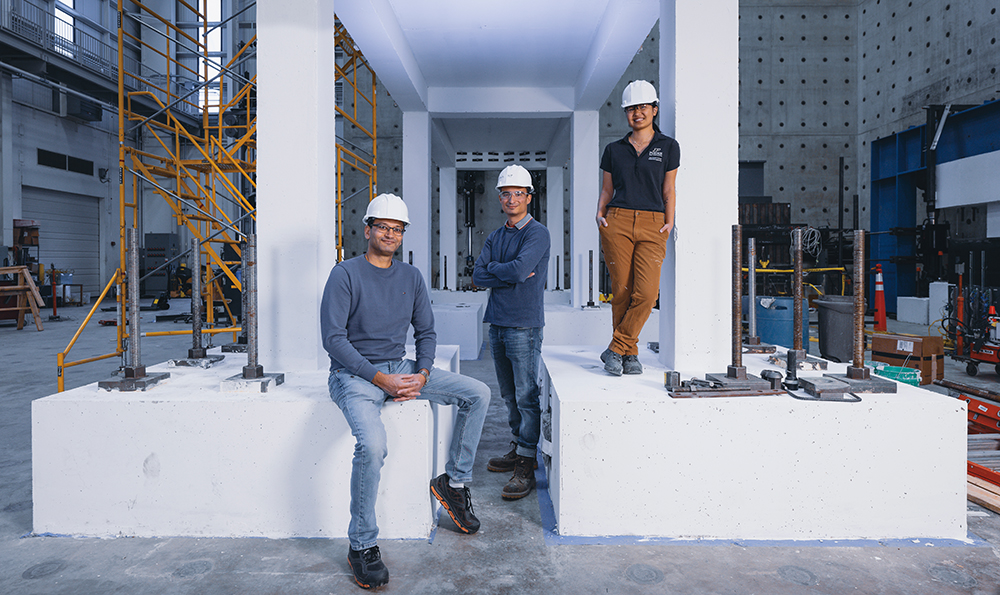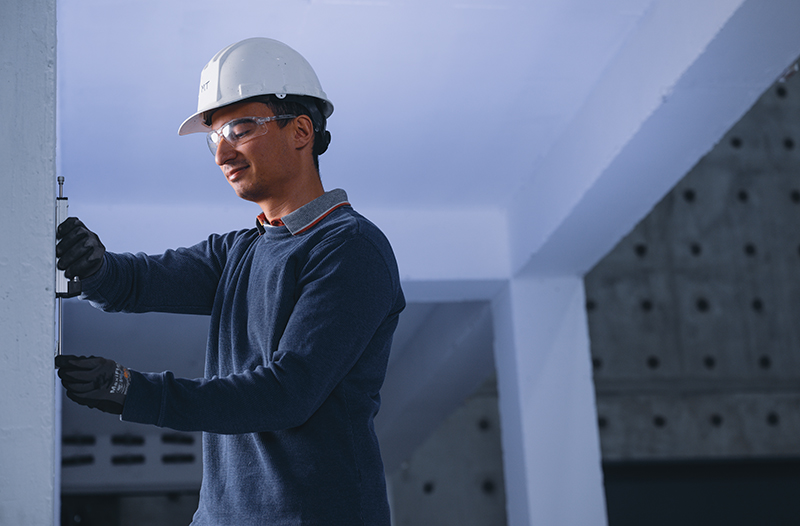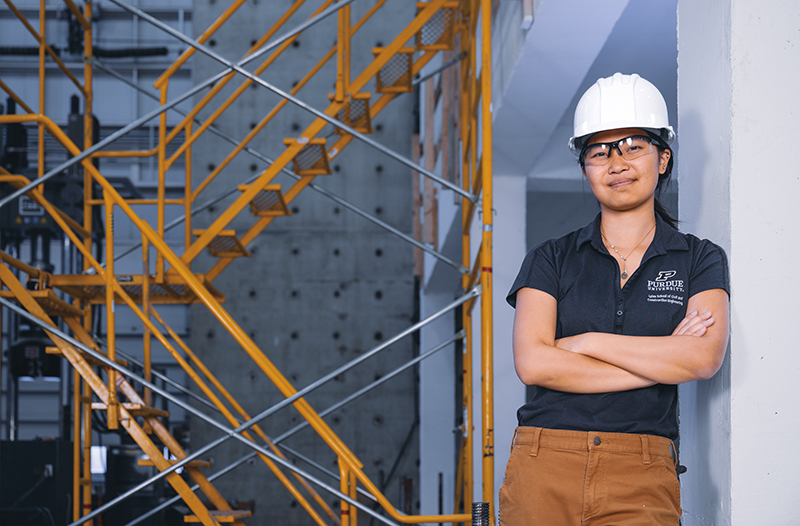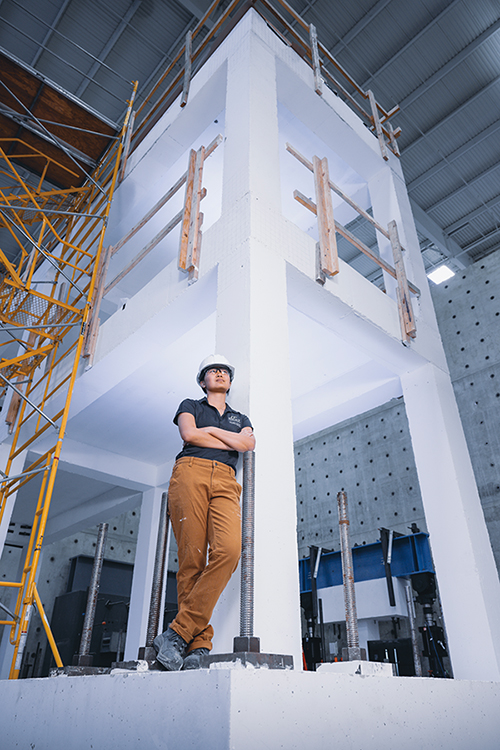Improving Earthquake Resilience

Akanshu Sharma (left), the Jack and Kay Hockema Associate Professor in Civil Engineering, leads a team investigating a new technique to reinforce concrete structures and protect them against earthquake damage. The team includes PhD candidate and lead project engineer Margaritis Tonidis (center) and undergraduate researcher Erin Plocinski (right).
Researchers test low-cost solution to reinforce aging concrete structures
Concrete structures of the past weren’t built to withstand the fury of an earthquake but a groundbreaking solution from researchers in the Lyles School of Civil and Construction Engineering could change that.
A research team led by Akanshu Sharma, the Jack and Kay Hockema Associate Professor in Civil Engineering and an expert in structural engineering hazard solutions, is testing a cost-effective, minimally invasive technique to fortify older concrete buildings against earthquakes, potentially saving lives and preserving structures worldwide. Their secret weapon? Using adhesive anchors to install metal braces — a simple yet ingenious retrofitting that could revolutionize how we protect our built environment from seismic disasters.
“Most of the techniques that currently exist in the field require some part of the existing structure to be demolished to access critical areas, which is very invasive and requires parts of the building to be closed for several months,” Sharma said. “We wanted to develop a minimally invasive solution that can be applied without disruption to the use of the building.”
The team’s novel approach involves installing haunches — metal triangular braces —to reinforce beam-column joints. The haunches are attached with post-installed adhesive anchors secured with epoxy mortar, so material cost is relatively low. There’s an additional indirect cost-savings by keeping the building’s functionality intact during installation of the haunches.
“Many solutions work well in the lab scale, but they are not practical enough to be applied in real life,” Sharma said. “I’ve been developing this method for the past 15 years and have finally reached a stage where it can be implemented in real life.”
To test the solution, the team erected a lifesize, two-story structure in the Bowen Laboratory for Large-Scale Civil Engineering Research. This first structure, without haunches, represents an older concrete building with connecting columns and beams that have not been reinforced to withstand seismic activity.
Using the strong wall in Bowen Lab, the team applied cyclical loads to the structure, mimicking the stresses and deformations in the frame members typically caused by an earthquake. The researchers then evaluated the behavior of various structural elements, such as the columns and beams, and measured the effects of the applied stress. This data can be used to verify available models in the field of research to predict the structural behavior of older buildings against lateral loads.
“The initial phase of testing involves an analysis of the vulnerability of existing reinforced concrete structures against joint shear failure,” said Margaritis Tonidis, a PhD candidate in the Lyles School of Civil and Construction Engineering at Purdue and the lead engineer on the project. “Beam-column joints are critical regions when it comes to lateral loading. In previous earthquakes, buildings have collapsed mainly due to joint shear failure.”

Margaritis Tonidis, lead project engineer, takes measurements on the life-size concrete structure built inside Bowen Lab.
To test how well the haunches and anchors perform, the team plans to create a second two-story structure, identical to the first. Construction of a second building is necessary because this technique isn’t designed to repair and strengthen an earthquake-damaged building, but to reinforce structures that could be susceptible to earthquakes in the future.
This time, the concrete beam-column joints will be strengthened with steel haunches. The post-installed anchors being used to secure the haunches are manufactured by Fischer, a global supplier of anchors and structural strengthening solutions and funder of the project.
“The effectiveness of the technique is dependent on many parameters, but the most important one is the performance of the anchors,” Tonidis said. “Different companies produce different products and different products mean different performance. We must understand the characteristics of this specific anchor we are using. Its strength, stiffness, behavior when intercepted by cracks in the concrete — these are all important considerations.”
The same quasistatic lateral loading procedure will be applied to the retrofitted concrete structure, and the same measurements will be taken. By comparing the two sets of data, the researchers will be able to determine the effectiveness of the haunches and anchors with respect to the seismic performance of the structure. If successful, the technique could be applied on a global scale, saving not only structures but the people who dwell and work within them.
“Around 50% of the reinforced concrete structures worldwide were designed without any seismic considerations,” Sharma said. “It’s as high as 90% in many developing countries. During earthquakes, these structures can be heavily damaged or collapse. It’s not just a matter of capital losses; it’s also the loss of human lives.”
An estimated 55,000 people died in the Turkey-Syria earthquake in February 2023. With the installment of haunches on older concrete buildings in areas susceptible to earthquakes, deaths of that scale could be preventable when future natural disasters strike.
Interest in the research has been stoked by a blind prediction competition where engineers can submit their guess as to how well the haunch and anchor solution will perform, potentially qualifying for a cash prize.
“We’ve received interest from all over the world,” Tonidis said. “We have submissions from Asia, Europe, South America — the implications of this research are far-reaching and the visibility of the project helps affirm Purdue’s status as a leading institution for civil and construction engineering research.”
The second phase of testing is slated to occur in May. Upon success of the experiment, Sharma hopes to commercialize the technology through Purdue Innovates and make it available to communities around the world.
“As civil engineers, we evaluate the aftermath of earthquake damage to assess what happened to the buildings,” Sharma said. “That’s the technical part of our work, but you cannot avoid seeing how people are affected. Earthquake disasters can have devastating effects. The aim of this study is to prevent that staggering level of loss. If the structures do not fail and people’s lives are saved, that has a much bigger impact than anything else.”

Erin Plocinski
From classroom theory to laboratory impact
The research has potential for worldwide impact, and it’s an example of the type of projects that undergraduate researchers in the Lyles School of Civil and Construction Engineering can work on.
“This is my first time seeing a large-scale structure intentionally being broken,” said Erin Plocinski, a junior from Indianapolis who is specializing in structural engineering. “It’s cool to witness that in person, but it’s even more interesting to see how the structural modifications we’re implementing could help the industry long-term.”
For Sharma, integrating undergraduate students into his research group is an essential part of the Purdue educational experience.
“In the classroom, we often look at lines and drawings and talk about how force is transferred,” Sharma said. “But when you test a lifesize structure in the lab, you can actually see the forces flowing and how the cracks are forming. Viewing something with your own eyes lends a different perspective to the application of theoretical concepts.”
The opportunity for Plocinski to contribute to a project centered on structures retrofitted for earthquake resilience not only expands her understanding of the discipline, but also affirms her passion for her chosen specialty.
“One of the reasons I chose to study civil engineering is because of the impact your work can have on a community,” she said. “I want to be able to create sustainable and safe buildings for people.”

